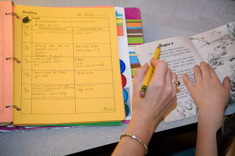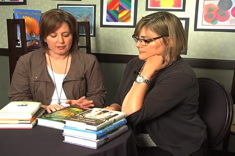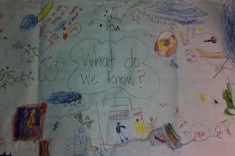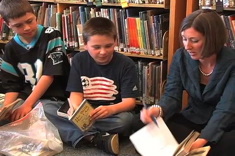The expression “from the mouths of babes” never holds more true than when you are teaching kindergartners! Last fall, a group of kindergarten students taught me a lesson that is still pushing my thinking as a teacher and a coach.
I (Clare) was coaching in a district with a group of about twenty teachers on interactive read aloud. The focus of our session together was using interactive read aloud to deepen comprehension, and model how to support thinking with evidence in the text. We met before the lesson to think through our text choice, stopping points, and strategies to get the students talking and responding to each other. We wanted to use a text we knew the students would connect to and would spark conversation. We found the perfect text: Knuffle Bunny by Mo Willems. We loved this choice because we knew the storyline would capture the students’ attention, the humor would engage them, and most students would connect with the main character, Trixie.
As we read through the book, we chose stopping points to model our thinking and to have students turn and talk about their thinking. We thought about big questions or big ideas that might be sparked by the story, and jotted down some ideas to help us guide the student conversation. We left for the demonstration lesson with a clear plan, a book full of post-it notes to flag our stopping points, and some ideas about where we would guide the conversation with the students.
I began to teach the lesson with the kindergarten students while the other teachers observed and took notes on areas of interest they chose. Everything was going so well, right according to plan. They laughed on cue, followed our thinking, and engaged in productive partner conversations. The scaffolding we had planned was working well to deepen comprehension through conversation. The students were not only talking, but listening and responding to each other. At the end of the book, I began talking about how authors sometimes have a big idea or a theme in their book. I explained how authors sometimes do this so that readers can learn something or experience something from reading a book.
They looked up at me with wide eyes, nodding their heads at every word. Then I went on to offer one of the big ideas I thought Mo Willems was sending to his readers:
Readers, I was thinking about the big ideas in this book. Sometimes when I think about the big ideas, I think about what I would say to the character or what I would do if I were the character. When I think about the characters it helps me figure out the big idea in the story. So readers, right here, when Trixie was looking for Knuffle Bunny and it was nowhere to be found. I was thinking I would tell Trixie, “Don’t bring things that are really important to you when you go out. If you bring them you might lose them and then you will be sad.” I might add, “Trixie, leave Knuffle Bunny home. It is too important and if you don’t want to lose it you should leave it where it’s safe.”
I was about to launch into the big idea when an arm shot up, followed by a huge sigh of frustration and disbelief. I tried to finish my thought, but then the student was up on her feet demanding to be heard.
“No, that is not what you would say to Trixie! If something is important to you then you should bring it with you always. That is what makes it important. The big idea is that you should be careful with it and take care of it always.”
There were a lot of eyes on me, and I must admit I was feeling a bit of pressure. I was not quite sure where to go with my best laid plans, so I followed up with the tried and true question, Why do you think that?
“Well my sister has cancer and she is very sick. We have to go to the hospital a lot so that she can get the medicine she needs to get better. When we go to the hospital my sister always wants to bring her special blanket and toy with her. They make her feel better. We make sure we always have it with us and never leave it anywhere. If you really love something then you bring it with you and you take care of it. That is Mo Willems’ big idea. So I would tell Trixie – if you really love that bunny then you should take better care of it. You are lucky you found it – you were not paying attention to it. Next time you might lose it if you are not more careful.”
How is it that I could read a book at least a hundred times with at least a thousand students and teachers and never see the book in this light? Now when I think about the title: Knuffle Bunny: A Cautionary Tale, I think about the words “cautionary tale” in a totally different way. Is Willems warning of the consequences of not taking a risk? Is the message that it is better to have loved and lost than never to have loved at all? What is the caution?
Big and Bigger Ideas
I think we could debate over the big idea in this story for a long time — there is no absolute answer. This experience is a cautionary tale for me. The research is compelling in supporting the importance of thoughtful curriculum planning. We need to know our objectives, our texts, and map out the trajectory of our lessons. We spend time collaborating on lesson planning and coaching around the essential components of a sound lesson. How do we balance this careful planning with allowing students to have authentic responses to a story? How do we provide guided practice, without guiding student thinking too much?
I worry that students too quickly learn that teachers have an answer in mind. Instead of truly thinking, they are busy trying to figure out what they think we want to hear. Readers need opportunities to respond authentically to literature, and have the freedom to express their thinking. As teachers we need to find the balance between explicit modeling to lift the quality of comprehension, and giving students space to pursue their own line of thinking and construct meaning for themselves. It will always be important to think through our lessons and the texts we are using before we share them with our students. I now also think about the many different ways a student may respond, and I am careful to let them know there are different perspectives. Two big ideas I learned:
- We need to leave room to hear what students are thinking, and never underestimate their ability to construct meaning from a text
- Ask students, “Why do you think that?” It opens up a world of understanding, and allows us to assess more authentically our students and ourselves.










